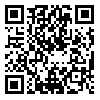Volume 15, Issue 7 (October 2017)
Nursing and Midwifery Journal 2017, 15(7): 544-558 |
Back to browse issues page
Download citation:
BibTeX | RIS | EndNote | Medlars | ProCite | Reference Manager | RefWorks
Send citation to:



BibTeX | RIS | EndNote | Medlars | ProCite | Reference Manager | RefWorks
Send citation to:
Adib-Hajbaghery M, Zare M. THE BARRIERS TO PATIENT EDUCATION FROM THE VIEWPOINT OF NURSES IN IRAN: A SYSTEMATIC REVIEW. Nursing and Midwifery Journal 2017; 15 (7) :544-558
URL: http://unmf.umsu.ac.ir/article-1-3304-en.html
URL: http://unmf.umsu.ac.ir/article-1-3304-en.html
1- Trauma Nursing Research Center, Faculty of Nursing, Kashan University of Medical Sciences, Kashan, Iran , adib1344@yahoo.com
2- Trauma Nursing Research Center, Faculty of Nursing, Kashan University of Medical Sciences, Kashan, Iran
2- Trauma Nursing Research Center, Faculty of Nursing, Kashan University of Medical Sciences, Kashan, Iran
Abstract: (10804 Views)
Background & Aims: Patient education is one of the important aspects of nursing care and key roles of nurses. In this context, recognizing its barriers can greatly influence on the process of improving the quality of patient education. The aim of this study was to investigate the barriers to patient education from the viewpoint of nurses in Iran.
Material & Methods: In this review study, research articles related to barriers of patient education from the viewpoint of nurses were searched in Persian and English languages and without time limitation in these databases: PubMed, ISI, ERIC, Science Direct, Scopus, Proquest, Google Scholar, MagIran, SID, IranDoc and IranMedex. Doing research in Iran was the main inclusion criterion. After evaluating entry criteria and quality of the articles, 24 articles were analyzed.
Results: A wide range of barriers were presented in studies. After the categorization, five main areas were identified: 1) Barriers related to nurses: Lack of time due to workload of nursing staffing 2) Barriers related to patients: the patient's unfavorable physical and psychic status 3) Management barriers: lack of managers' support 4) Organizational obstacles: the inappropriateness of nurse-patients ratio 5) Environmental barriers: lack of cooperation of the medical team members to implement educational programs.
Conclusion: Most of the barriers to patient education are those of related to nurses. To improve the status of patient education, it is essential for managers to encourage nurses in this important task by adopting measures such as increasing in nursing staffing, allocating sufficient funds and proper supervision.
Type of Study: Review article |
Subject:
پرستاری
Send email to the article author
| Rights and permissions | |
 |
This work is licensed under a Creative Commons Attribution-NonCommercial 4.0 International License. |






 gmail.com, unmf
gmail.com, unmf